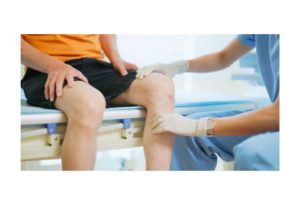
Non-Surgical Treatment Pathway
Note: The information that follows is for educational purposes only and is not a substitute for seeing a licensed healthcare professional face-to-face for a thorough physical examination and treatment recommendations.
Every day there are injured Canadians who get better and return to work or sports without the need for an X-ray, prescription medication, an injection, or an MRI.
This short article identifies the stages in the non-surgical treatment pathway of musculoskeletal/orthopaedic injuries and conditions.  Step 1:
Step 1:
Physician Appointment
- The goals of seeing a physician are to rule out medical conditions that require urgent care (for example fractures, tumors) and to get an accurate and reliable diagnosis as soon as possible.
- An accurate clinical diagnosis can only be made from a face-to-face, physical examination.
- Depending on the pattern of your complaints and a physical examination, your physician may;
- Refer you for diagnostic imaging
- Prescribe medications
- Refer you to physiotherapy
- Recommend activity modifications at work, at home, or in sports.
Step 2:
Protection (Early Healing)
- Stage two consists of protection at the site of injury.
- Protection at the site of injury allows early repair tissue to form and prevents accidental re-injury.
- Protective devices including casts, slings, braces, splints, and crutches are often used BUT only for a short period.
- Not all injuries require a protective device.
- How long a joint or tissue needs to be protected depends on (1) what tissue has been injured, (2) the amount of tissue damage (3) the vascularity of the injured tissue, and (3) the age and medical profile of the patient.
- Premature exercise or activity can result in re-injury, delayed healing, chronic pain, and disability.
- Ultimately your physician and/or your physiotherapist will determine how long to protect your injured tissue before safely progressing to stage three.

Stage 3
Early Exercise (Range of Motion)
- Although protecting a joint in a cast or brace can be helpful, it can lead to joint stiffness as well as a loss in muscle strength.
- Stage three consists of gentle exercises to restore the joint range of motion and prevent loss of muscle strength.
- Exercises are performed slowly and carefully during this stage to prevent disturbing immature repair tissue at the site of injury.
- Your physiotherapist will select safe and appropriate mobility exercises based on your injury and stage of tissue healing.
Stage 4:
Middle Exercise (Muscle Strength)
- Stage four consists of restoring full muscular strength and endurance – without disturbing repair tissue at the site of injury.
- Early strength exercises involve light resistance and progress based on your injury and stage of tissue healing.
- Your physiotherapist will select safe and appropriate strength exercises.
Late Exercise (Neuromuscular Function)
- Stage five consists of rehearsing neuromuscular “motor programs” also known as “motor tasks” or “motor skills”. Essentially, every task or skill we learn is stored in our brain and executed when we need it. Typically the more we use these tasks or skills, the better we perform them.
- Unfortunately in the early stages of tissue healing we tend to be less active which can lead some motor programs to becoming “rusty”.
- The goal in this stage is to restore the speed and accuracy of motor programs in order to prevent re-injury from a premature return to work or sports.
- During this stage your physiotherapist will design a safe and appropriate exercise program to improve performance of specific work or sports tasks.
Stage 6:
Medical Clearance
- Stage six consists of seeing your physician or physiotherapist for medical clearance before returning to work full duties and/or sports.
- Returning to work or sports prematurely and without medical clearance can result in delayed healing, chronic pain, and permanent disability – that may not be corrected by surgery.



